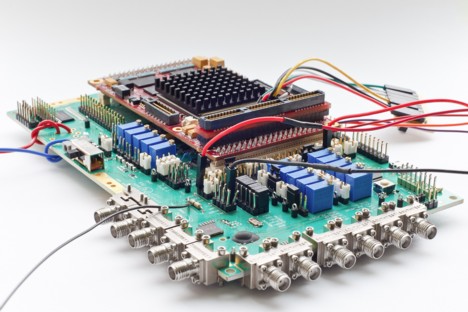Home > Press > Chip with IR-UWB technology enables low-power, high-quality wireless audio streaming
 |
| UWB: test board with IR-UWB chip developed by imec and Holst Centre |
Abstract:
mec and Holst Centre have reached a breakthrough in low-power wireless streaming of high-quality music, for example between a smartphone and a hearing aid, or between the two earpieces of a headset. The new solution is a fully chip-integrated ultralow-power IR-UWB (impulse-radio ultra-wideband) solution for use in the worldwide available 6-10GHz band. The IR-UWB link streams high-quality music over a distance of up to 20m. It uses up to 5 times less energy than a Bluetooth connection. In addition, the link is more resilient against fades and interference from other RF systems.
Chip with IR-UWB technology enables low-power, high-quality wireless audio streaming
Leuven, Belgium | Posted on March 16th, 2012
The new radio can be used for binaural audio streaming between 2 earpieces of a headset or a hearing aid. This is a technical breakthrough because the propagation channel for RF communication from one ear to the other is known as being extremely challenging. In a wider context, the IR-UWB link today covers a distance of 20m for an indoor channel. This distance enables the wireless streaming of high quality audio between a headset and for instance a streaming device anywhere in the living room.
IR-UWB communication is especially suited for short-range communication and positioning sensors. The large bandwidth improves the resilience against fades, resulting in a superior communication reliability. This is especially so compared to narrowband solutions. Also, spreading information over a wide bandwidth decreases the power spectral density, thus reducing the interference with other systems and lowering the probability of interception. IR-UWB is also suitable for positioning sensors; the transmission of very short pulses, with only nanosecond duration, allows for centimeter-range positioning accuracy.
Imec and Holst Centre's solution consists of a transmitter, receiver front-end, and receiver digital baseband. The transmitter delivers 13dBm peak power, with an average power consumption of 3.3mW. The receiver front-end shows -88dBm sensitivity at 1Mbps. A digital synchronization algorithm enables real-time duty cycling, resulting in a mean power consumption of 3mW. A DCO with 100ppm frequency accuracy and a baseband frequency tracking algorithm ensure the coherent reception. A 75dB link budget with a data rate of 1Mbps is achieved.
Companies can have access to this technology by joining imec and Holst Centre's R&D program on ultralow-power wireless systems.
####
For more information, please click here
Contacts:
Barbara Kalkis
Maestro Marketing & PR
Copyright © IMEC
If you have a comment, please Contact us.Issuers of news releases, not 7th Wave, Inc. or Nanotechnology Now, are solely responsible for the accuracy of the content.
| Related News Press |
News and information
![]() Researchers develop molecular qubits that communicate at telecom frequencies October 3rd, 2025
Researchers develop molecular qubits that communicate at telecom frequencies October 3rd, 2025
![]() Next-generation quantum communication October 3rd, 2025
Next-generation quantum communication October 3rd, 2025
![]() "Nanoreactor" cage uses visible light for catalytic and ultra-selective cross-cycloadditions October 3rd, 2025
"Nanoreactor" cage uses visible light for catalytic and ultra-selective cross-cycloadditions October 3rd, 2025
Chip Technology
![]() Lab to industry: InSe wafer-scale breakthrough for future electronics August 8th, 2025
Lab to industry: InSe wafer-scale breakthrough for future electronics August 8th, 2025
![]() A 1960s idea inspires NBI researchers to study hitherto inaccessible quantum states June 6th, 2025
A 1960s idea inspires NBI researchers to study hitherto inaccessible quantum states June 6th, 2025
![]() Programmable electron-induced color router array May 14th, 2025
Programmable electron-induced color router array May 14th, 2025
Announcements
![]() Rice membrane extracts lithium from brines with greater speed, less waste October 3rd, 2025
Rice membrane extracts lithium from brines with greater speed, less waste October 3rd, 2025
![]() Researchers develop molecular qubits that communicate at telecom frequencies October 3rd, 2025
Researchers develop molecular qubits that communicate at telecom frequencies October 3rd, 2025
![]() Next-generation quantum communication October 3rd, 2025
Next-generation quantum communication October 3rd, 2025
![]() "Nanoreactor" cage uses visible light for catalytic and ultra-selective cross-cycloadditions October 3rd, 2025
"Nanoreactor" cage uses visible light for catalytic and ultra-selective cross-cycloadditions October 3rd, 2025
Alliances/Trade associations/Partnerships/Distributorships
![]() Chicago Quantum Exchange welcomes six new partners highlighting quantum technology solutions, from Chicago and beyond September 23rd, 2022
Chicago Quantum Exchange welcomes six new partners highlighting quantum technology solutions, from Chicago and beyond September 23rd, 2022
![]() University of Illinois Chicago joins Brookhaven Lab's Quantum Center June 10th, 2022
University of Illinois Chicago joins Brookhaven Lab's Quantum Center June 10th, 2022
|
|
||
|
|
||
| The latest news from around the world, FREE | ||
|
|
||
|
|
||
| Premium Products | ||
|
|
||
|
Only the news you want to read!
Learn More |
||
|
|
||
|
Full-service, expert consulting
Learn More |
||
|
|
||








